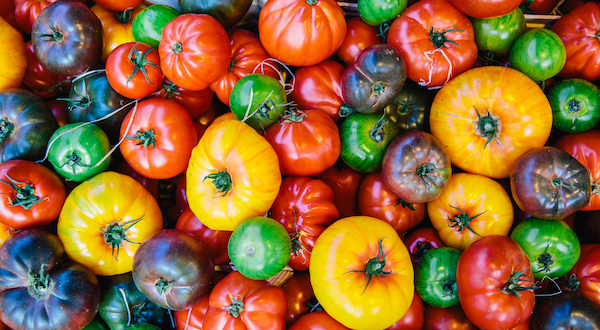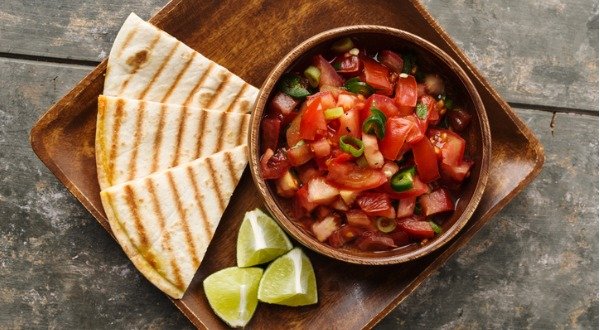Believe it or not, the health benefits of tomatoes for fighting cancer are pretty legendary—and fully backed by science too! Read on about how research is setting the record straight regarding the health benefits of tomatoes, including their cancer-protective properties.
Health Benefits of Tomatoes
Let’s take a look at the long list of the health benefits of tomatoes first, and then we will discuss how researchers have traced these benefits to particular substances. According to recent studies, tomatoes can have substantial benefits for:
- Heart health
- Blood pressure regulation
- Younger looking skin and hair
- Bone health
- Lowering homocysteine levels
- Lifting mood and curbing depression
- Protecting against the damaging UV rays of the sun
- Assisting with weight loss and fat absorption
- Smoking cessation support
- Preventing DNA damage
- Preventing and possibility helping to heal cancers such as prostate, pancreatic, lung, endometrium, breast, and stomach
What Makes Tomatoes So Healthy?
The key to all of these health benefits has to do with the fruit’s rich phytonutrient content, as well as its vitamin and mineral content. Side note: yes, a tomato is technically a fruit since it contains a flower and seeds, although some experts call it a vegetable.
Whether they are red, yellow or purple, tomatoes are a rich source of many nutrients such as vitamin C, vitamin E, vitamin K, potassium, copper, manganese, folate, and fiber.
It is a particular kind of carotenoid called lycopene that gives tomatoes their cancer-fighting edge, however. A 2005 Canadian study found that “a diet rich in tomatoes and tomato-based products with high lycopene content may help reduce pancreatic cancer risk.”
Other antioxidants such as alpha-lipoic acid, choline, beta-carotene, and lutein provide even more nutrition and protection against disease. Finally, tomatoes only have about 32 calories per cup, making them a good choice for those who want a healthy way to reduce calories.
What About Nightshades and Cancer?
Tomatoes belong to a group of plants called “nightshades.” The nightshade family is also known as Solanaceae; all plants in this category produce an alkaloid compound called solanine. Solanine is a natural insect repellent.
Some people avoid nightshades because they are thought to increase inflammation. Many professionals, on the other hand, recommend them as part of an anti-inflammatory diet.
So what gives?
The truth is that most nightshades don’t contain enough solanine to cause any significant harm for the majority of people. For most people, the dozens of other healthy phytonutrients in nightshades help to actually lower inflammation and prevent disease.
That being said, a small percentage of individuals are extra sensitive to solanine. For those individuals, ingesting any amount of nightshades would cause inflammation.
In addition, it is important for everybody to avoid certain sources of high solanine, such as the leaves and stems of nightshade plants and “potato eyes” (i.e. the sprouts that form on potatoes if you leave them in the bag too long).
What Are the Best Ways to Eat a Tomato?
Unlike many antioxidant-rich foods, tomatoes are still beneficial when they’ve been processed. Canned tomato products, tomato juice and even ketchup can still have a high lycopene content. In a report for the Food Science & Nutrition Journal in 2019, Japanese researchers found that unsalted tomato juice improved blood pressure in local residents who were at risk of cardiovascular system conditions.
That being said, some tomato-based products like pasta sauce and ketchup are notorious for being very high in sugar, especially high fructose corn syrup. Be sure to check the sugar and additive content in these products especially. In addition, make sure that your canned tomatoes are stored in a BPA-free container. The high acid content in tomatoes makes leaching of toxins in cans more of a concern.
Finally, while canned, jarred, sauced, juiced and even jellied tomatoes can all be good for you, the most benefits are going to come when tomatoes are picked fresh right off the vine, when they are organic and, ideally, when they are of an heirloom variety.
In 2015, scientists at the Kew Gardens in London found that certain “natural defenses” which had been “bred out” of commercial varieties were present in heirloom varieties. They also found higher levels of the super antioxidant lycopene (mentioned earlier).
Tomatoes grown at Kew had a much higher level of complexity of chemicals than supermarket tomatoes, which are picked early and not matured on a vine,” commented Professor Monique Simmonds, Deputy Director of Science at Kew. “…The complexity of chemistry suggests that they are likely to be healthier.”
Eat Your Way to a Cancer-Free Life…With Tomatoes!
Your diet is a crucial aspect of total body wellness. Choose wisely, shop responsibly, eat cleanly, and reap the benefits for decades to come. Organic tomatoes are one item from your local produce department, farmer’s market or your own backyard that you can eat every day for good health!
Easy, Healthy Tomato Recipes
#1. The Only Cancer-Fighting Salsa You’ll Ever Need!
Ingredients:
- 2 cups tomatoes, washed and diced (2-3 medium tomatoes)
- 1 (28-ounce) can organic crushed tomatoes, undrained
- 1 full garlic bulb, peeled and chopped
- 1 small pepper (pick your favorite variety), finely chopped
- 1 bunch green onions, chopped fine
- ½ cup fresh cilantro, chopped
- 1 tablespoon fresh oregano, chopped
- 1 tablespoon apple cider vinegar
- 1 teaspoon lime juice
- Salt and pepper to taste (optional)
Directions:
- Combine all ingredients in a glass dish.
- Stir until well blended.
- Chill for one hour.
- Serve with pita crisps or homemade tortilla chips
Note: Consider adding sweet corn kernels or drained black beans for chunkier salsa!
#2. Artichoke and Roasted Tomato Flatbread
Instead of ordering pizza packed with junk that causes cancer, drives up your blood sugar, and clogs your arteries, how about making your own pizza at home?
Ingredients:
- 2 cups tomatoes, washed and diced (2-3 medium tomatoes)
- ½ garlic bulb, peeled and chopped
- 1 (13-ounce) can artichoke hearts, drained and diced
- 2 teaspoons extra-virgin olive oil
- 2 rectangular flatbreads or no-bread option such as sliced eggplant or Portobello caps
- ¼ cup finely grated or shredded Parmesan cheese
- 2 cups arugula
- 1/4 cup shaved Parmesan cheese
- Oregano, salt and pepper to taste
Directions:
- Preheat broiler of your oven.
- Toss tomatoes, garlic, and artichokes with 1 teaspoon oil, and arrange in a shallow baking pan.
- Broil, stirring occasionally, for 4 minutes.
- Lower oven temperature to 450° Fahrenheit.
- Top each flatbread with half the tomato mixture.
- Sprinkle with fresh parmesan and preferred spices.
- Bake on bottom rack of oven for 10 minutes.
- While the pizza is baking, toss arugula with remaining parmesan, lemon juice, remaining olive oil.
- Serve pizza in wedges with light arugula salad on the side.
Note: Consider adding finely diced plain sardines, grilled chicken, or organic sausage for added protein or if you want a meat variety.
Editor’s Note: This article was initially published in January 2020 and was updated in February 2021.






















Hello Ty & Charlene, My name is Melissa I’m 52 years old. I have been a user and firm believer of herbs and healthy foods since I was very young. I was raised to respect Gods beautiful earth. All the wonderful plants he created are so amazing the way they heal and protect us. I sure wish that everyone could respect it also. I’m so thankful for you two; You have brought out knowledge and information (with documents and testimonials to prove it.)for the whole world to utilize. You are amazing and my whole family thanks you. We will never stop passing this info around. By the way, love the salsa recipe. God bless you…love you guys.
Thank you Melissa! Your comment means so much to us. <3 God bless you.
Interesting. I LOVE tomatoes, but every year for several years now, we plant them (they are the only food that we plant), they do well for a while and then blight takes over and kills the plants. Plus the woodchucks help themselves to them – ugh! We get some good tasting tomatoes from them, but they never get as big as they should before the blight kills the plants. I tried looking online to find ways to fight the blight, which helped a little this past year (delayed it’s appearance a little), but they still got it. Am about ready to give up. Wish I knew how to avoid it or if some varieties are more resistant than others.
My husband and I are retired Master gardrners. We have worked in a large garden that’s donates fresh vegetables to food pantries in our area. We grow lots of tomatoes. Make sure you give them plenty of space to allow for good air circulation and plant in full sun. If we see any blight on the plants we pull out the whole plant because it spreads fast. We have found a variety called Tasty Lee that does very well even in clay soil. If you have clay soil you could amend it with gypsum which will break down the clay. Also we found a product called sarinade that is organic and works well for fungal diseases. Hope this helps.
Don’t give up! It takes time to learn. I learn to kill plants less as I go. Haha! Check out the Back to Eden method on youtube and Facebook. They are based in Oregon? but that method works everywhere with a few tweaks for your area. Use low or no till methods. We grow organic heirloom tomatoes that we raise ourselves from seed, with all the colors. They are yummy! 🙂 Don’t water above the plant, but water at the base and keep leaves pruned at the bottom so it doesn’t pick up disease. Plant wide apart. We grow them on cattle panels. This method with lots of mulch, really helps keep down weeds, keeps moisture in the soil, and makes it easier to garden, even here in hot, weedy South Texas. We’ve done it 6 years now with this method. Before this, it was so much harder.
Hello Maureen.
have you looked into a home-made solution for blight? I was using a 0.5L sprayer bottle with a recipe that I found somewhere online: before filing up with warm/hot water, I was dropping somewhere around a teaspoon of cooking oil, another with dish soap (or Castille soap if you have any), shake them both well to emulsify, then add the water, and when all has mixed in together nicely, add about half a teaspoon of baking soda. Let the mix cool down a bit, then spray the underside of the affected leaves as well with it, and repeat about once per week.
I grew clean tomato, peppers, potato and tomatillo plants last season, all of which got blight within a few weeks of being transplanted to the yard from pots that I started them in. I was also going over to my neighbors’ yard and spraying their tomato plants as well, some of which were looking very sad from blight as well, and those plants healed and grew nice and strong, and produced a solid crop too.
Hope this helps.
E.
I came across a man that had beautiful tomatoes, so I asked him how he done it. He said to me he used to put a handful of milk powder under the plants when he planted them for extra calcium. So I tried it and it worked,but the next year it didn’t, so when I changed spots it worked again.So I had to plant them in a different spot each time,hope this helps, worth a try best of luck.
What sugars can you recommend . What about honey, maple syrup, Coconut sugar, stevia, monk fruit sugar?
Hi Sibylle, here is a list of our favorite sweeteners: https://thetruthaboutcancer.com/best-keto-sweeteners/ & https://thetruthaboutcancer.com/stevia/. And these are the ones we suggest staying away from: https://thetruthaboutcancer.com/artificial-sweeteners-cancer-risk/. We hope this helps!
When I make pizza, I usually tend to use fresh tomatoes no matter what season it is. When I make the pasta sauces such as tuna fish sauce, pea sauce, and tomato sauce, I use tin cans of tomatoes without salt and mix it with fresh tomatoes because it tastes fresher this way.
Great choice, Silvia! We always recommend to make sure all cans are BPA free as well.
Do you have any information about what gluten is doing to our bodies? How they have changed the wheat? How to deal with the food allergies and intestinal issues we are having.
Hi Vicki, great question! This is a very important topic and we’ve written about it a bit in a few different articles We will pass this topic on to Ty & Charlene for a more comprehensive article. In the mean time, many experts suggest starting with an elimination diet to identify the issue: https://thetruthaboutcancer.com/how-to-do-an-elimination-diet/ and this article on food & inflammation: https://thetruthaboutcancer.com/foods-that-cause-inflammation/ may also help. The book Wheat Belly sums up the science and the history of how wheat has changed. Most importantly, organic & non-GMO is always the way to go if possible. We hope this helps!
Hi to the lady with the tomatoe blight….copper! You can by copper powder and spray your tomatoes. And, this is quirky, but an old fashion secret. Plant real copper pennies here and there in your garden. I remember when I was young my Dad digging up pennies out of his soil. He always wondered why they were there. When I lived in Vancouver Canada, a gentleman from Portugal told me about the copper…I never had another problem with the dreaded blight that ravaged all of our tomatoes. Hope this helps you! Ty and Charlene💕💕💕
Louise Williams-AWESOME suggestion!!!!!!!!!!!!!!!!!!!!!!!!!—i actually was given a bracelet YEARS ago made from pure copper-it was made in an artist’s colony in Italy and the maker recommended the bracelet for healing us humans–so if it helps us, VERY likely to help plants as well!!!!!
Amazing! Tomatoes are really underrated. I always add tomatoes when I’m making scrambled eggs. I’ll try to make “Artichoke and Roasted Tomato Flatbread”. Thanks for sharing this helpful information.
That sounds fantastic! Thank you so much for being here with us!
Dear TY and Charlene. Many years ago i had cancer. After few weeks of chemotherapy y decided not to follow treatment with pills or radiation. Instead i started to follow natural protocols like Dr Johanna Budwic. My husband made a huge pot with italian tomato sauce as we believe that the COOKED tomato is better for cancer and we freezed in paper cups. Every day i would eat as much as i could of the sauce with toasted bread. Delicious and i feel somehow it did help me to get my smell back and my body to strenghten a bit again.
Sadly it’s hard to find ANY organic tomatoes that are NOT “FAKE ORGANIC”. All the he health stores now carry only hydroponically grown and though marked with the “USDA Organic” label, they are fed conventional {monsanto) feed and hotshouses are sprayed w/ toxic/poison chemicals. Few tomatoes are still grown in soil to avoid all this.
Unless I can get some locally grown, so far not doable, fresh tomatoes are out.
Most dried are out too except for Frontier tomato flakes. And some canned is OK, like Jovial. Or products with tomato, like some Amys soups. I have called to find out if tomatoes used in there are grown in soil.
My original sources for all this: An old Dr. Mercola article, leading to the Cornucopia website, regarding hydroponics in organ. Cornucopia [the watchdog site, that exposed Horizon dairy scandal] is a good place to start for research into what I am speaking of here and the site has a 4 page list of hydroponically grown foods [to avoid].
I agree that otherwise tomatoes are awesome, if you can find real ones and I’m encouraged that cooking does not remove many of the benefit you speak of here, as being now stuck w/ canned.
Thanx for this article.